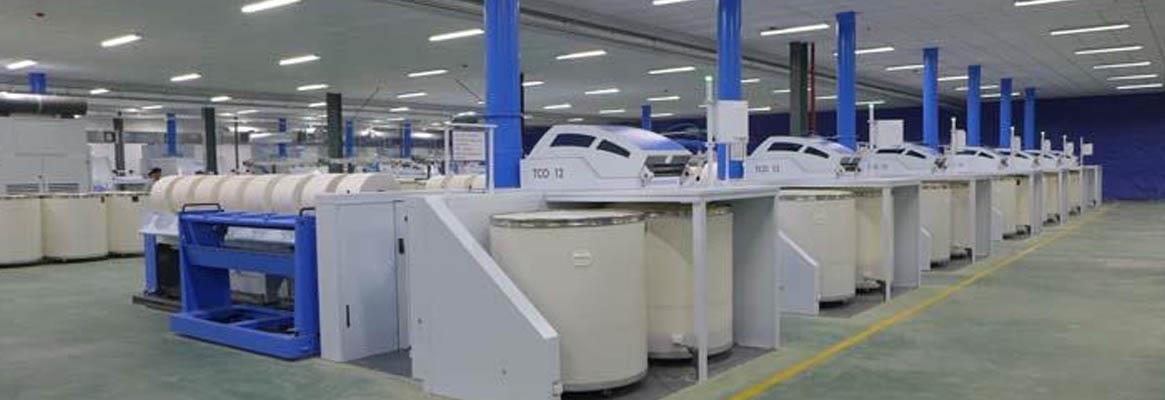Dry wipes or wet wipes usually cause issues with sewagesystems due to their failure to disintegrate in water. To counter this problem,Voith Group (Division: Paper) and Truetzschler Nonwovens joined hands todevelop flushable wipes. These wipes can be flushed down the toilet becausethey disintegrate into individual fibres in agitated water.
Wet-LayingTechnology
The wet-laid process for nonwovens is similar to themaking of paper. The first step involves suspension of fibres and water to forma slurry, so that single fibres of different types are evenly distributed in the water. The web formed ispassed over a wire belt. When water is sucked off, a homogeneous fibre mat isformed. The spunlacing process performed by the AquaJet system on this fibremat further produces nonwovens that feel like textile.
Unlike a carding process where longer fibres are required,wet-laying can utilise short fibres of 2 mm to up to 15 mm to form the web. Inprinciple, every fibre that is dispersed in water can be wet-laid. Hence,fibres of low cost like wood pulp i.e., cellulose fibres, man-made and mineralfibres, etc., can be used. The WLS (wet-laying/spunlacing) process goes withoutbinders by hydro-entangling the single fibres. Wipes produced throughwet-in-wet processes are extremely versatile.
Truetzschler Nonwovens in collaboration with Voith Paperoffers the following solutions for manufacturing wet-laid nonwovens:
HydroFormer fromVoith Group
Most conventional dry or air-laid sheet forming processesare based on the use of long fibres. This meant that in the past, it was oftennot possible to use the less expensive and more environmentally compatible pulpfibres for nonwoven production. To close this gap, Voith's HydroFormer acts asa bridge between paper and nonwoven production.
The HydroFormer concept for wet-laid nonwovens builds onVoith's longstanding experience from the paper and pulp industry. Inexpensiveand biodegradable, thanks to a very high dilution in suspension, nonwovensproduced by the HydroFormer can be produced entirely out of renewable,cost-efficient cellulose feedstock. Apart from the obvious cost savings andenvironmental benefits, this process offers homogeneous sheet formation andconsiderable flexibility for multi-ply end products. It also enables themanufacturing of disposable cleaning wipes from 100% biodegradable materials.
Voith Group's HydroFormer has been specifically optimisedfor the formation of wet-laid nonwovens and, with more than 70 successfulinstallations, has gained worldwide acceptance.
AquaJet forspunlacing from Truetzschler Nonwovens
After the web is formed inthe HydroFormer, it needs to be bonded to add strength and function.
Compared with other web bonding methods, the AquaJet spunlacing process does not use chemical binding agents or bicomponent fibres, but relies only on the momentum of water jets to entangle the fibres with one another. Continuous high-pressure water jets strike the loose nonwoven web, which is moved through on a belt underneath the water bar, while suction fans remove the water used. The bonding increases tensile strength and lends the material the soft feel of a textile. Structures and perforations can also be created, if required.
Benefits of the AquaJet
• Use of environmentally friendly and inexpensive raw materials
• Soft nonwovens
• Natural bonding process using water only
• High savings potential - thanks to optimised pump and vacuum performance
• Integrated system for excellent nonwoven quality
In harmony with the environment
Apart from short fibres being used, the Voith-Truetzschler process avoids the use of chemical binders to bond the web formed. This reduces the raw material cost for making nonwovens. Compared to oil-based materials like PET/PP fibres, cellulose fibres do not burden the environment after use. Wipes produced entirely from these degradable fibres in a customised wet-laid spunlacing process can therefore be conveniently flushed down the toilet.
Both the AquaJet and the HydroFormer have been developed with water conservation in mind. The water from the process is filtered via a shared water cycle with downstream production steps, and then treated and returned to the manufacturing process.
Flushable products must pass a defined test sequence developed by INDA and EDANA, the North American and European nonwovens associations.

About Voith Paper:
Founded in 1867, Voith Paper is a pioneer and a leading partner to the paper industry. Through constant innovation, Voith Paper is optimising the paper manufacturing process, focusing on developing resource-saving products to reduce the use of energy, water, and fibres. Voith is headquartered in Germany and has sales & manufacturing worldwide.
About Truetzschler:
Truetzschler, founded in 1888, is a family-owned German company with global operations that specialises in the manufacture of machines, installations, and accessories for spinning preparation, nonwovens and man-made fibre.










Comments